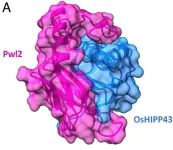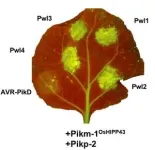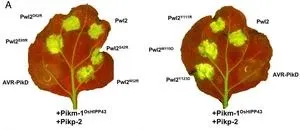By modifying a plant intracellular immune receptor (NLR), researchers have developed a potential new strategy for resistance to rice blast disease, one of the most important diseases threatening global food security. The collaborative team from the UK and Japan have recently published their research in PNAS. This could have implications for future approaches to crop protection and ultimately global food supply stability.
The research was led from the Department of Biochemistry and Metabolism at the John Innes Centre, with partners at The Sainsbury Laboratory, University of East Anglia, and the Division of Genomics and Breeding, Iwate Biotechnology Research Center, Japan. For a critical part of the study, the researchers worked with the UK’s national synchrotron, Diamond Light Source. Their paper, “Bioengineering a plant NLR immune receptor with a robust binding interface toward a conserved fungal pathogen effector”, was published in early July (https://doi.org/10.1073/pnas.2402872121)
Rice blast disease remains one of the most recalcitrant diseases threatening global food security. This disease is caused by the filamentous fungus, Magnaporthe oryzae and is directly responsible for the loss of more than 30% of harvested rice annually. This pathogen can also cause blast disease on other cereal crops including wheat and barley.
Current approaches to deployment of durable disease resistance in the field are limited by the pace they can be identified in nature and the evolution of plant pathogens such as the blast fungus that manage to bypass these new resistances. Bioengineering of plant immune receptors such as NLRs has emerged as a new path for generating novel disease resistance traits to counteract the expanding threat of plant pathogens to global food security that can potentially be developed on demand.
Rafał Zdrzałek, the lead author explains “Pathogens secrete proteins called “effectors” into host cells to manipulate plant metabolism and promote infection. Plants can recognise these effectors using immune receptors called NLRs. However, it’s not always easy to define a receptor naturally recognising any given effector, and even if such receptor exists, pathogen’s effectors can mutate and evolve to escape that recognition. Interactions between pathogen effectors and plant receptors are studied to understand the modus operandi of each pathogen, but also allows us to tinker with the natural plant receptors and alter their recognition specificity.”
In their publication the researchers focused on engineering an NLR immune receptor from rice to robustly bind a broader, conserved effector family from the blast fungus pathogen. Mark Banfield, the corresponding author, adds; “By recognising a conserved effector family, this engineered immune receptor establishes a proof-of-principle for future delivery of robust, longer-lived blast disease resistance in agriculture. It may be more difficult for the pathogen to evolve to escape recognition. The concept of host-target immune receptor engineering may also be applicable to other plant diseases that rely on delivery of effectors into host cells for their disease-causing properties.”
By exchanging the heavy metal–associated (HMA) domain of the rice NLR Pikm-1 with that from the rice protein OsHIPP43 (the natural target of the Pwl2 effector), the researchers successfully changed the receptor's response profile to recognise and respond to Pwl2 and the broader Pwl effector family.
The researchers collected X-ray diffraction data at the I04 beamline of the UK’s national synchrotron, Diamond Light Source to study the details of the interaction between these two proteins. The crystal structure of the complex reveals an extensive interface between Pwl2 and OsHIPP43 (fig. 1).
Figure 1: Transparent surface representation of Pwl2 (pink) and OsHIPP43 (blue)
Interestingly, the researchers performed assays to show that the new chimeric protein could recognise different Pwl effectors (fig. 2) in planta.
Figure 2: Cell death assay showing the Pikm-1OsHIPP43/Pikp-2 chimera recognizes Pwl effector variants on expression in N. benthamiana.
To explore the limits of the chimeric protein, they generated series of targeted mutations in Pwl2 based on the crystal structure, and performed new assay to test for altered recognition specificities. In many cases, the protein could recognise the effector, showing the robustness of the system. (fig. 3)
Figure 3: Cell death assays showing recognition of all single Pwl2 point mutants by the chimeric Pikm-1OsHIPP43/Pikp-2 receptor, despite deliberate targeting of mutations at the Pwl2/OsHIPP43 interface.
The study's findings demonstrate the potential of host target-based NLR engineering in developing new resistance traits that could be less prone to being overcome by pathogen evolution. This research could have far-reaching implications for the future of crop protection and global food supply stability.
To find out more about the I04 beamline or discuss potential applications, please contact Principal Beamline Scientist Ralf Flaig ralf.flaig@diamond.ac.uk
ENDS -
Paper: “Bioengineering a plant NLR immune receptor with a robust binding interface toward a conserved fungal pathogen effector”, July 5, 2024 https://doi.org/10.1073/pnas.2402872121
Authors and affiliations: Rafal Zdrzalek, Yuxuan Xi, Thorsten Langner, Mark J. Banfield +9 Authors Info & Affiliations
Further information please contact: mark.banfield@jic.ac.uk
For further information: please contact Diamond Communications: Lorna Campbell +44 7836 625999 or Isabelle Boscaro-Clarke +44 1235 778130 Diamond Light Source: www.diamond.ac.uk Twitter: @DiamondLightSou
The John Innes Centre, located in Norwich, Norfolk, England, is an independent centre for research and training in plant and microbial science founded in 1910. It is an international centre of excellence in plant science, genetics and microbiology. Its research aims to address global challenges, and new knowledge of plants and microbes is used to answer fundamental questions, as well as having a significant impact on industrial biotechnology, society and global development.
The John Innes Centre fosters a creative, curiosity-driven approach to fundamental questions in bio-science, with a view to translating that into societal benefits. Over the last 110 years, we have achieved a range of fundamental breakthroughs, resulting in major societal impacts. The director of the John Innes Centre is Professor Graham Moore FRS.
Diamond Light Source provides industrial and academic user communities with access to state-of-the-art analytical tools to enable world-changing science. Shaped like a huge ring, it works like a giant microscope, accelerating electrons to near light speeds, to produce a light 10 billion times brighter than the Sun, which is then directed off into 33 laboratories known as ‘beamlines’. In addition to these, Diamond offers access to several integrated laboratories including the world-class Electron Bio-imaging Centre (eBIC) and the Electron Physical Science Imaging Centre (ePSIC).
Diamond serves as an agent of change, addressing 21st century challenges such as disease, clean energy, food security and more. Since operations started, more than 16,000 researchers from both academia and industry have used Diamond to conduct experiments, with the support of approximately 760 world-class staff. Almost 12,000 scientific articles have been published by our users and scientists.
Funded by the UK Government through the Science and Technology Facilities Council (STFC), and by the Wellcome Trust, Diamond is one of the most advanced scientific facilities in the world, and its pioneering capabilities are helping to keep the UK at the forefront of scientific research.
Diamond was set-up as an independent not for profit company through a joint venture, between the UKRI’s Science and Technology Facilities Council and one of the world’s largest biomedical charities, the Wellcome Trust - each respectively owning 86% and 14% of the shareholding.
END









